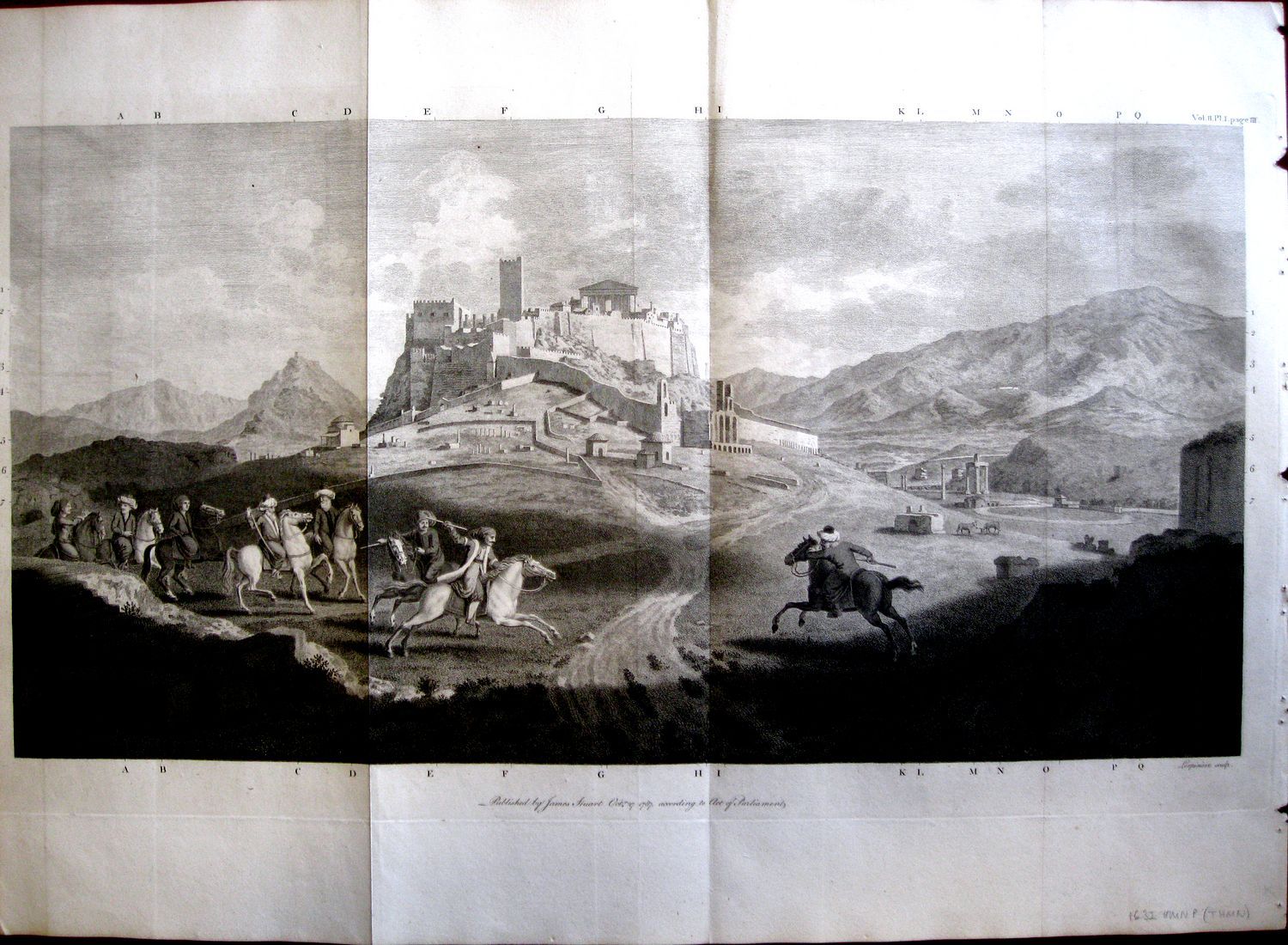Greece: London John Nichols. 1787. Large copper engraved panoramic view of the Acropolis. from the second volume of Stuart & Revett's "Antiquities of Athens". This magnificent view engraved from sketches made by James Stuart during his and Nicholas Revett's surjourn in Athens 1751-55, shows the position of the Acropolis and the various attendant temples. and buildings. In the foreground he depicts a group of eminent Turks engaged in Jereet. The personages depicted include the Vaïvode of Athens, about to throw the jereet, the Disdár Agá, and the Mudereese Effendi " conversing with Achmét Agá, the richest and most respectable Turkish gentleman of Athens:". Stuart, whilst engaged in a project which was scientific in bases, i. e. to "Measure and Delineate" the antiquities in Athens, also shows a diplomatic touch by portraying such eminent Turks in this distinguished view. Stuart and Revett had not been permitted to survey the Acropolis until a few months before they left Greece, so perhaps it was a tribute to those who had finally given permission. Clean. dark impression; folded; left margin cut short by binder to edge of platemark; right margin outside platemark shows were the plate was bound into the volume. "The Antiquities of Athens. Measured and Delineated by James Stuart. F. R. S and F. S. A and Nicholas Revett, Painters And Architects. " was published in 5 volumes between 1762 and 1830. "But Athens the Mother of elegance and politeness, whose magnificence scarce yielded to that of Rome, and who for the beauties of a correct style must be allowed to surpass her; has been almost entirely neglected. So that unless exact copies of them be speedily made, all her beauteous Fabricks, her Temples, her Palaces, now in ruins, will drop into Oblivion; and Posterity will have to reproach us, that we have not left them a tolerable Idea of what was so excellent, and so much deserved our attention; but that we have suffered the perfection of an Art to perish, when it was perhaps in our power to have retrieved it. . . . We have therefore resolved to make a journey to Athens; and to publish at our return, such Remains of that famous City as we may be permitted to copy, and that appear to merit our attention. . . . " Proposals for publishing an accurate description of the Antiquities of Athens (1748) In the preface to volume 1 Stuart states that there have already been many works on the ancient edifices of Rome but that: "altho' the World is enriched with Collections of this sort already published, we thought it would be a Work not unacceptable to the lovers of Architecture, if we added to those Collections some Examples drawn from the Antiquities of Greece; and we were confirmed in our opinion by this consideration principally, that as Greece was the great Mistress of the Arts, and Rome, in this respect, no more than her disciple, it may be presumed, all the most admired Buildings which adorned that Imperial City, were but imitations of Grecian Originals, ". The first volume of "The Antiquities of Athens" was published in 1762 and was a huge success gaining Stuart the soubriquet "Athenian Stuart". Revett perhaps peeved by the acclaim received by his partner, or annoyed at the delay in publication, which had allowed Julien-David Le Roy to pre-empt them in 1758. with his "Les Ruines and plus Beaux Monuments de la Gréce. " gave up his rights to the succeeding volumes. Their partnership had dissolved in 1759, but Stuart eventually was given permission to use those drawings for his second volume, which was devoted to the Acropolis, including the Parthenon, Erechtheion and Propylaea. It was published posthumously in 1789, a year after Stuart's death (the title page actually bears the date 1787 and the volume may have been published in January 1790). Here, the descriptions are more brief, in part because Stuart did not deign to respond to Le Roy's criticism that: "The ruins of antiquity may be looked at in widely differing ways. In publishing them, one may undertake no more than a slavish record of their dimensions; and the most scrupulous accuracy in doing so is, in Mr. Stuart's opinion, almost the only merit that a book of this kind can possess. My journey, I confess, was undertaken with very different ends in view; I would never have traveled to Greece simply to observe the relations of the buildings and their parts with the subdivisions of our foot. Such a claim to fame I gladly resign to anyone who desires it and aspires to nothing higher. . . . As for the vast quantity of plates with which works of the present kind are sometimes laden, these often convey nothing to the public beyond the industry or the want of taste of those who have measured the monuments" (Preface, Vol. I, 2nd edition 1770). He continued :"In the views that I present, the ruins occupy a far greater part of the picture than in those of Mr. Stuart; they make a livelier impression on the viewer and fill his mind with all the admiration that strikes us when we see the monuments themselves" (Preface, Vol. I). Stuart had accused Le Roy of plagarism, and inaccuracies in his preface to the first volume and so the acrimonious exchange continued between the two, to the detriment and benefit of both works. : Stuart must have such a image in mind when he proclaimed in the Preface to his own volume that "The Views were all finished on the spot; and in these, preferring Truth to every other consideration, I have taken none of those Liberties with which Painters are apt to indulge themselves, from a desire of rendering their representations of Places more agreeable to the Eye and better Pictures. Not an Object is here embellished by strokes of Fancy, nor is the situation of any one of them changed. . . " (p. viii). A third volume (which included the Temple of Hephaestus, Hadrian's Arch, and Temple of Olympian Zeus) was published in 1794 and, from notes and drawings acquired from Stuart's daughter, a fourth volume in 1816, prompted, no doubt, by the British Museum's purchase of the Elgin marbles that year and the debate as to whether they were truly Periclean or merely Roman restorations. In 1830, the year that Greece was declared an independent monarchy, there was a final volume with the same title but written by a new generation of British architects. Smaller abridged copies also were made available as guides for travelers. Blackmer/Navari: 1618; BAL RIBA :3183. Greece Athens Acropolis






